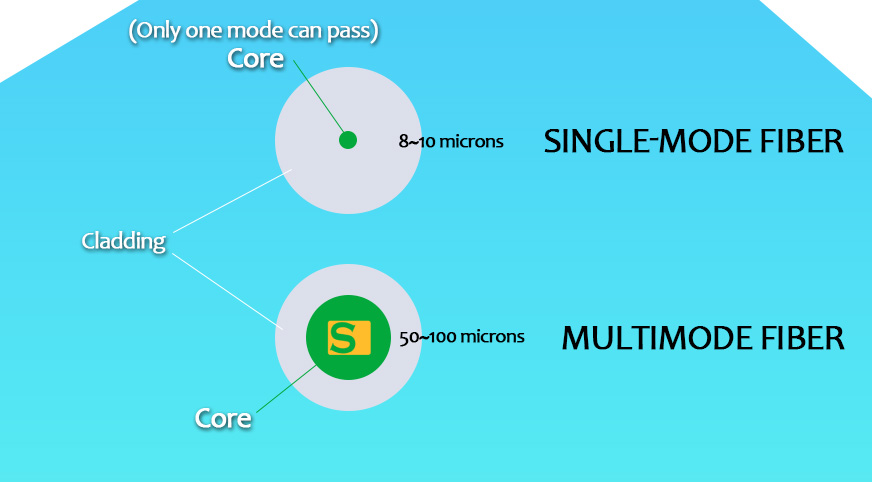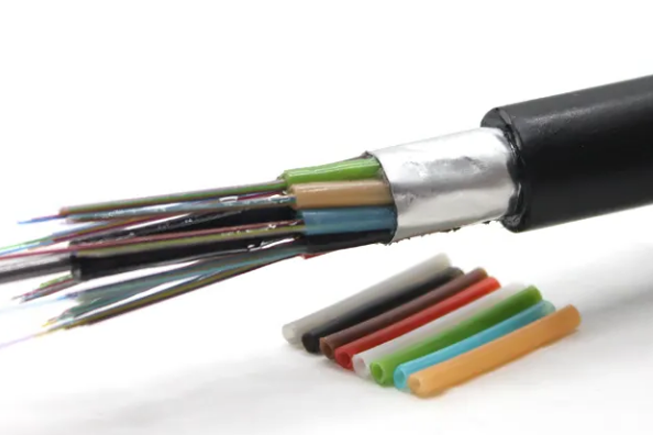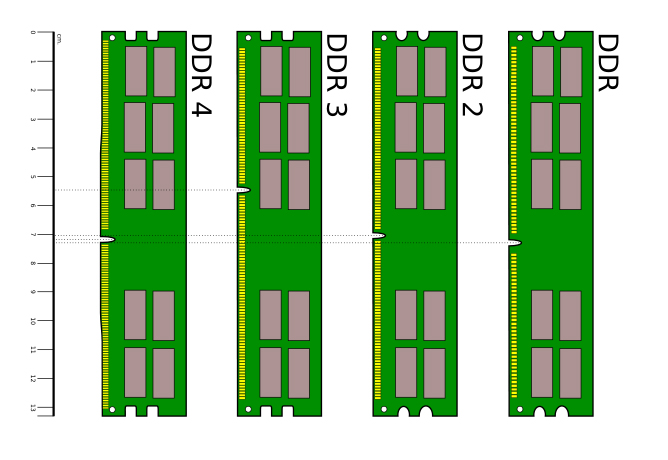
OM1 vs OM2 vs OM3 vs OM4 vs OM5: Multimode Fiber Cable Differences
Introduction
In modern networking, multimode fiber optic cables are important in ensuring efficient and high-speed data transmission. They are used in data centers, enterprise networks, and telecommunications infrastructures. As the demand for higher bandwidth and faster data transfer rates continues to surge, selecting the appropriate type of multimode fiber optic cable becomes crucial to meet these evolving requirements.
Multimode fibers are categorized into different types based on their performance characteristics, primarily denoted as OM1 through OM5. Each category represents advancements in technology, catering to varying networking needs and applications. This article aims to elucidate the differences among OM1, OM2, OM3, OM4, and OM5 multimode fibers, guiding you in making informed decisions for their networking solutions.
What is Multimode Fiber Optics?
Multimode fiber optic cables are designed to carry multiple modes or light paths simultaneously. They have larger core diameters, typically ranging from 50 to 100 microns, allowing multiple light modes to propagate. This characteristic makes them suitable for short to medium-distance applications where high data rates are essential.
Technical Characteristics of Multimode Fiber
- Light Source Types: Multimode fibers primarily use low-cost light sources such as Light Emitting Diodes (LEDs) and Vertical-Cavity Surface-Emitting Lasers (VCSELs).
- Operating Wavelengths: Common operational wavelengths include 850 nm and 1300 nm, optimized for different transmission needs.
- Modal Bandwidth, Attenuation, and Dispersion: These fibers exhibit varying modal bandwidths, attenuation rates, and dispersion characteristics, influencing their performance over distances and data rates.
Applications of Multimode Fiber
Multimode fibers are predominantly used for short-distance connections, up to approximately 550 meters, making them ideal for within-building installations like office complexes, data centers, and campus environments. They support high-speed data transmission protocols, including Ethernet, Fibre Channel, and others.
Further Reading: Single Mode vs. Multimode Fiber: Key Differences and How to Choose
Overview of OM1 to OM5 Multimode Fibers
The International Organization for Standardization (ISO) and the International Electrotechnical Commission (IEC) established the ISO/IEC 11801 standard, which defines the specifications for OM1 through OM5 multimode fibers. This standardization ensures compatibility and performance consistency across different fiber types and manufacturers.
Release Dates and Technical Background
- OM1 (1989): The first standardized multimode fiber, introducing a foundation for subsequent advancements.
- OM2 (1998): Enhanced performance over OM1, targeting better bandwidth and transmission capabilities.
- OM3 (2003): Optimized for laser-based equipment, supporting higher data rates and longer distances.
- OM4 (2009): Further improvements in bandwidth and attenuation, suitable for advanced data center environments.
- OM5 (2016): Introduced to support Short-Wavelength Division Multiplexing (SWDM), enabling multiple wavelengths on a single fiber.
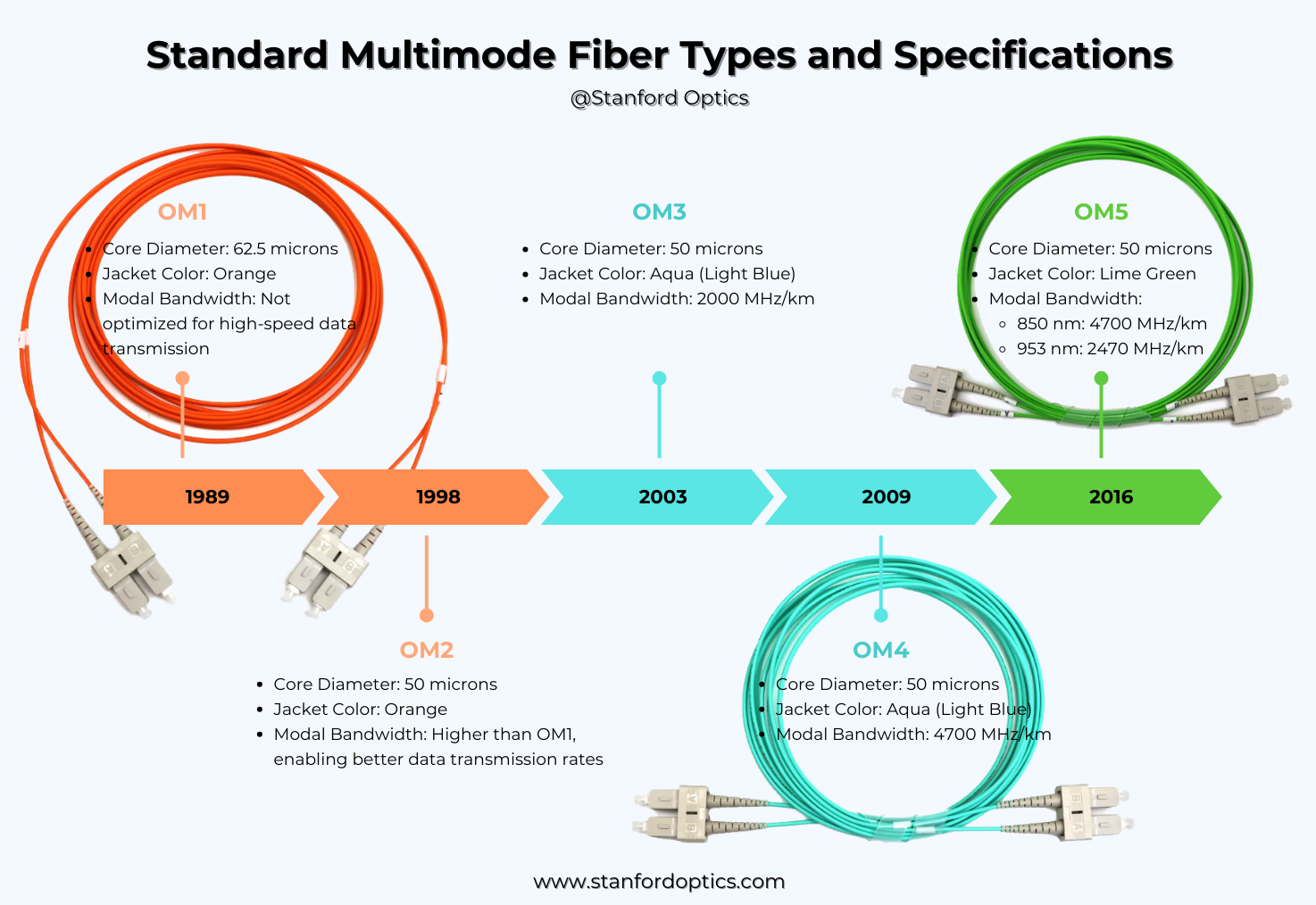
Detailed Comparison of OM1 to OM5 Multimode Fibers
OM1 Fiber
1. Standardization
Standardized in 1989, OM1 was the inaugural multimode fiber type, setting the stage for future developments in fiber optic technology.
2. Technical Specifications
- Core Diameter: 62.5 microns
- Jacket Color: Orange
- Modal Bandwidth: Not optimized for high-speed data transmission
3. Light Source
Utilizes LEDs (Light Emitting Diodes) as the primary light source, which are cost-effective but have lower performance compared to laser-based sources.
4. Application Scenarios
Primarily used for 100Mbps Ethernet transmission links, suitable for basic networking needs within smaller environments.
5. Transmission Capabilities
- 1G Ethernet: Up to 275 meters
- 10G Ethernet: Up to 33 meters
OM2 Fiber
1. Standardization
Introduced in 1998, OM2 enhanced the capabilities established by OM1, offering improved performance metrics.
2. Technical Specifications
- Core Diameter: 50 microns
- Jacket Color: Orange
- Modal Bandwidth: Higher than OM1, enabling better data transmission rates
3. Light Source
Also employs LEDs, continuing the cost-effective approach while delivering enhanced performance.
4. Application Scenarios
Ideal for 1000Mbps (1G) Ethernet interconnections, making them suitable for medium-sized enterprise networks.
5. Transmission Capabilities
- 1G Ethernet: Up to 550 meters (potentially up to 2 kilometers under optimal conditions)
- 10G Ethernet: Up to 33 meters
OM3 Fiber
1. Standardization
Standardized in 2003, OM3 fibers were engineered to support laser-based optical components, marking a significant technological leap.
2. Technical Specifications
- Core Diameter: 50 microns
- Jacket Color: Aqua (Light Blue)
- Modal Bandwidth: 2000 MHz/km
3. Light Source
Utilizes VCSELs (Vertical-Cavity Surface-Emitting Lasers), which offer higher performance and efficiency compared to LEDs.
4. Application Scenarios
Designed for high-speed applications including 10G, 25G, 40G, and 100G Ethernet networks, catering to modern data center demands.
5. Transmission Capabilities
- 10G Ethernet: Up to 220 meters
- 25G Ethernet: Up to 70 meters
- 40G/100G Ethernet: Up to 100 meters
OM4 Fiber
1. Standardization
Released in 2009, OM4 fibers provided further enhancements in bandwidth and attenuation, optimizing them for advanced networking environments.
2. Technical Specifications
- Core Diameter: 50 microns
- Jacket Color: Aqua (Light Blue)
- Modal Bandwidth: 4700 MHz/km
3. Light Source
Continues the use of VCSELs, ensuring high compatibility with high-speed networking equipment.
4. Application Scenarios
Suited for high-speed networks, including data centers, financial institutions, and large-scale enterprise campuses requiring robust and reliable connectivity.
5. Transmission Capabilities
- 10G Ethernet: Up to 400 meters
- 25G Ethernet: Up to 100 meters
- 40G Ethernet: Up to 150 meters
- 100G Ethernet: Up to 100 meters
OM5 Fiber
1. Standardization
Officially released in 2016, OM5 represents the latest advancement in multimode fiber technology, designed to support innovative transmission methods.
2. Technical Specifications
- Core Diameter: 50 microns
- Jacket Color: Lime Green
- Modal Bandwidth:
- 850 nm: 4700 MHz/km
- 953 nm: 2470 MHz/km
3. Technical Features
OM5 fibers are engineered to support Short-Wavelength Division Multiplexing (SWDM), allowing multiple wavelengths to transmit simultaneously on a single fiber strand. This capability significantly increases the fiber's data carrying capacity without additional infrastructure.
4. Application Scenarios
Ideal for emerging high-bandwidth applications such as 200G and 400G Ethernet networks. OM5 fibers facilitate multi-wavelength transmissions, making them suitable for next-generation data centers and high-performance computing environments.
5. Transmission Capabilities
- Maximum Distance: Up to 150 meters
6. Advantages
OM5 fibers enable the transmission of multiple signals through a single fiber, optimizing fiber usage and enhancing network capacity. This feature is particularly beneficial in scenarios where fiber resources are limited or cost constraints are significant.
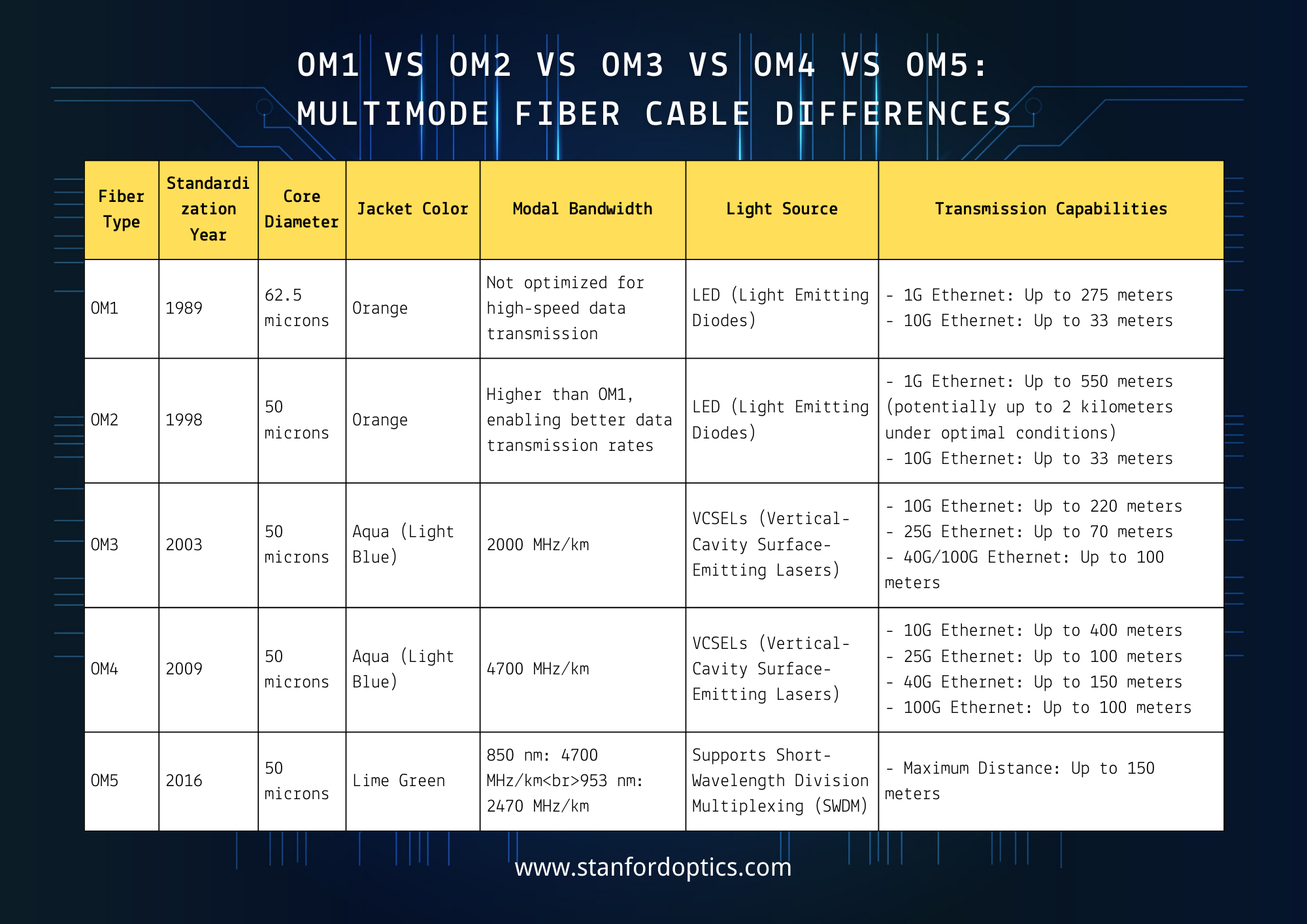
Technical Specifications Comparison
Modal Bandwidth
Modal bandwidth indicates the fiber's ability to handle higher data rates over longer distances. The progression from OM1 to OM5 shows a significant increase in modal bandwidth, enhancing data transmission capabilities.
- OM1: Lowest bandwidth, suitable for basic networking needs.
- OM2: Improved bandwidth compared to OM1.
- OM3: High bandwidth optimized for laser sources.
- OM4: Superior bandwidth for advanced networking.
- OM5: Maintains high bandwidth with added SWDM support.
Attenuation and Dispersion
Attenuation refers to signal loss over distance, while dispersion affects signal integrity. Each subsequent fiber type from OM1 to OM5 exhibits better attenuation and dispersion characteristics, ensuring more reliable and efficient data transmission.
Compatibility
Multimode fibers generally maintain backward compatibility, allowing newer fiber types to work with older networking equipment to some extent. However, optimal performance is achieved when both fiber and equipment are matched correctly. Compatibility issues may arise when mixing different fiber types or outdated components, potentially limiting the network's performance capabilities.
Typical Application Scenarios
Data Centers
Data centers require high-density and high-speed connections to manage vast amounts of data seamlessly. OM3, OM4, and OM5 fibers are particularly suited for these environments due to their high bandwidth and support for advanced networking protocols.
Enterprise Networks
Within large office buildings and corporate campuses, multimode fibers facilitate short-distance interconnections, ensuring reliable and fast communication between different network segments and devices.
High-Speed Networks
Industries such as finance and research demand extremely fast and stable data transmission. Multimode fibers, especially OM4 and OM5, cater to these needs by providing the necessary bandwidth and low attenuation rates.
Specialized Applications
Advanced environments that leverage SWDM technology benefit from OM5 fibers, which support multiple wavelengths on a single fiber. This capability is essential for cutting-edge Ethernet networks and other high-capacity applications.
Cost Considerations
Cost of Fiber Types
The price of multimode fibers increases from OM1 to OM5, reflecting the technological advancements and improved performance. OM1 and OM2 fibers are generally more affordable, making them suitable for budget-conscious projects, while OM3, OM4, and OM5 offer better performance at higher costs.
Cost of Electronic Components
Different light sources and transceivers impact overall costs:
- LEDs: Used in OM1 and OM2, are cost-effective but offer lower performance.
- VCSELs: Employed in OM3 and OM4, provide better performance at a higher cost.
- SWDM Transceivers: Required for OM5, entail additional expenses due to their advanced capabilities.
Overall Network Construction Costs
Choosing the appropriate fiber type involves balancing initial costs with long-term performance benefits. While higher-grade fibers like OM4 and OM5 may have higher upfront costs, they can offer greater scalability and longevity, potentially reducing the total cost of ownership over time.
Frequently Asked Questions (FAQ)
A. What is the difference between VCSEL and LED?
VCSELs (Vertical-Cavity Surface-Emitting Lasers) offer higher performance, including better modulation speeds and longer transmission distances, compared to LEDs (Light Emitting Diodes). VCSELs are typically used in higher-grade multimode fibers like OM3, OM4, and OM5.
B. What is Effective Modal Bandwidth (EMB)?
Effective Modal Bandwidth (EMB) measures a fiber's capacity to carry different light modes without significant signal degradation. Higher EMB values indicate better performance for high-speed data transmission.
C. What differentiates OM3 from OM4?
OM3 fibers are optimized for laser-based equipment with a modal bandwidth of 2000 MHz/km, suitable for 10G Ethernet over 220 meters. OM4 fibers enhance this with a modal bandwidth of 4700 MHz/km, supporting longer distances and higher data rates, such as 40G Ethernet over 150 meters.
D. How does OM4 differ from OM5?
OM4 fibers maintain high modal bandwidth and are optimized for laser sources, while OM5 fibers introduce support for Short-Wavelength Division Multiplexing (SWDM). This allows OM5 fibers to carry multiple wavelengths simultaneously, increasing data capacity without additional fibers.
E. What is Laser Optimized Multimode Fiber (LOMMF)?
Laser Optimized Multimode Fiber (LOMMF) refers to fibers like OM3, OM4, and OM5 that are specifically designed to work with laser-based light sources (e.g., VCSELs), enabling higher performance and longer transmission distances compared to fibers optimized for LED sources.
F. What does "OM" represent in OM1 to OM5?
"OM" stands for Optical Multimode, indicating the fiber type's classification within the multimode fiber spectrum.
G. Are OM1 to OM5 fibers backward compatible?
Generally, newer multimode fibers like OM3, OM4, and OM5 can be backward compatible with older fibers such as OM1 and OM2. However, to achieve optimal performance, matching fiber types with appropriate networking equipment is recommended.
H. What is the maximum transmission distance for multimode fibers?
Transmission distances vary based on the fiber type and data rate:
- OM1: Up to 275 meters for 1G Ethernet and 33 meters for 10G Ethernet.
- OM2: Up to 550 meters for 1G Ethernet and 33 meters for 10G Ethernet.
- OM3: Up to 220 meters for 10G Ethernet.
- OM4: Up to 400 meters for 10G Ethernet and 150 meters for 40G Ethernet.
- OM5: Up to 150 meters, supporting multiple wavelengths.
Conclusion
Multimode fibers OM1 through OM5 offer varying levels of performance, bandwidth, and transmission capabilities. From the basic OM1 suitable for lower-speed applications to the advanced OM5 designed for high-capacity, multi-wavelength environments, each fiber type serves distinct networking needs.
When choosing the appropriate multimode fiber type, consider factors such as required data rates, transmission distances, budget constraints, and future scalability. For modern, high-speed data centers, OM4 or OM5 may be ideal, while OM1 and OM2 could suffice for smaller, budget-sensitive projects.
At Stanford Optics, we specialize in providing high-quality fiber optic solutions tailored to meet diverse infrastructure demands. Whether you need single-mode or multimode fiber, our team is ready to help you design and implement a reliable, efficient network. Contact us today to learn how we can support your connectivity goals.

